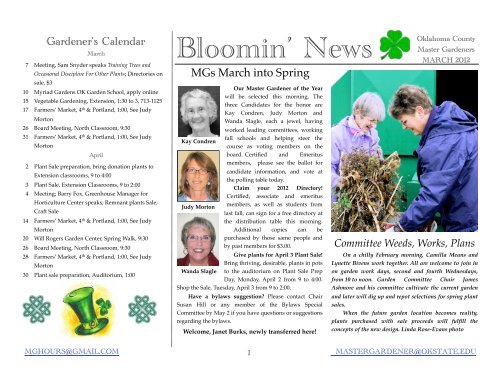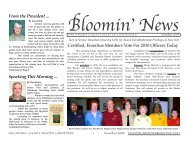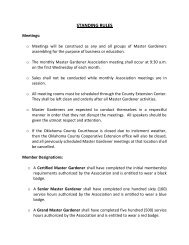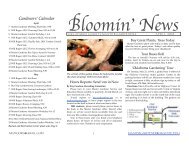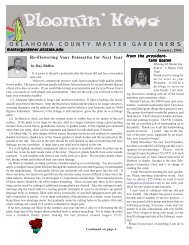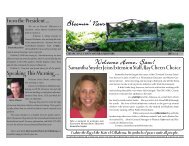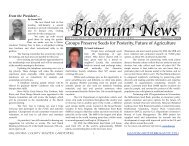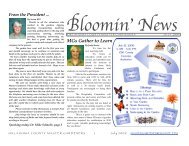Bloomin' News - Oklahoma County Master Gardeners
Bloomin' News - Oklahoma County Master Gardeners
Bloomin' News - Oklahoma County Master Gardeners
Create successful ePaper yourself
Turn your PDF publications into a flip-book with our unique Google optimized e-Paper software.
Gardener’s Calendar<br />
March<br />
7 ! Meeting, Sam Snyder speaks Training Trees and<br />
! Occasional Discipline For Other Plants; Directories on<br />
! sale, $3<br />
10! Myriad Gardens OK Garden School, apply online<br />
15! Vegetable Gardening, Extension, 1:30 to 3, 713-1125<br />
17! Farmers’ Market, 4 th & Portland, 1:00, See Judy<br />
! Morton<br />
26! Board Meeting, North Classroom, 9:30<br />
31! Farmers’ Market, 4 th & Portland, 1:00, See Judy<br />
! Morton<br />
April<br />
2! Plant Sale preparation, bring donation plants to<br />
! Extension classrooms, 9 to 4:00<br />
3! Plant Sale, Extension Classrooms, 9 to 2:00<br />
4! Meeting; Barry Fox, Greenhouse Manager for<br />
! Horticulture Center speaks; Remnant plants Sale;<br />
! Craft Sale<br />
14! Farmers’ Market, 4 th & Portland, 1:00, See Judy<br />
! Morton<br />
20 ! Will Rogers Garden Center, Spring Walk, 9:30<br />
26! Board Meeting, North Classroom, 9:30<br />
28! Farmers’ Market, 4 th & Portland, 1:00, See Judy<br />
! Morton<br />
30 ! Plant sale preparation, Auditorium, 1:00<br />
Bloomin’ <strong>News</strong><br />
MGs March into Spring<br />
! Our <strong>Master</strong> Gardener of the Year<br />
will be selected this morning. The<br />
three Candidates for the honor are<br />
Kay Condren, Judy Morton and<br />
Wanda Slagle, each a jewel, having<br />
worked leading committees, working<br />
fall schools and helping steer the<br />
Kay Condren<br />
course as voting members on the<br />
board. !Certified and Emeritus<br />
members, please see the ballot for<br />
candidate information, and vote at<br />
the polling table today.<br />
! Claim your 2012 Directory!<br />
Certified, associate and emeritus<br />
Judy Morton<br />
members, as well as students from<br />
last fall, can sign for a free directory at<br />
the distribution table this morning.<br />
! Additional copies can be<br />
purchased by those same people and<br />
by past members for $3.00.<br />
! Give plants for April 3 Plant Sale!<br />
Bring thriving, desirable, plants in pots<br />
Wanda Slagle to the auditorium on Plant Sale Prep<br />
Day, Monday, April 2 from 9 to 4:00.<br />
Shop the Sale, Tuesday, April 3 from 9 to 2:00.<br />
! Have a bylaws suggestion? Please contact Chair<br />
Susan Hill or any member of the Bylaws Special<br />
Committee by May 2 if you have questions or suggestions<br />
regarding the bylaws.<br />
Welcome, Janet Burks, newly transferred here!<br />
<strong>Oklahoma</strong> <strong>County</strong><br />
<strong>Master</strong> <strong>Gardeners</strong><br />
MARCH 2012<br />
Committee Weeds, Works, Plans<br />
! On a chilly February morning, Camilla Means and<br />
Lynette Bivens work together. All are welcome to join in<br />
on garden work days, second and fourth Wednesdays,<br />
from 10 to noon.! Garden Committee Chair James<br />
Ashmore and his committee cultivate the current garden<br />
and later will dig up and repot selections for spring plant<br />
sales.<br />
! When the future garden location becomes reality,<br />
plants purchased with sale proceeds will fulfill the<br />
concepts of the new design. Linda Rose-Evans photo<br />
MGHOURS@GMAIL.COM<br />
1<br />
MASTERGARDENER@OKSTATE.EDU
From the President ...<br />
Surprise! Plant Babies in Pots Thrive in Disposable Diapers<br />
By Peggy Garrett<br />
! There's nothing like a snowstorm to put<br />
a damper on your gardening dreams.<br />
! As I sludged my way to my car to clear off Mother<br />
Nature's latest gift, there they were … beautiful little<br />
daffodils poking their heads out of the snow. Talk about<br />
perseverance! These guys were some I bought at the MG<br />
bulb sale last year; so far I'm impressed with their<br />
performance.<br />
! There are lots of advantages to being a member of<br />
OK <strong>County</strong> <strong>Master</strong> <strong>Gardeners</strong>: bulb and plant sales,<br />
unique garden craft items, excellent speakers and learning<br />
opportunities, trips and tours, and don't forget about the<br />
food!<br />
! I hope you'll poke your head out of the snow and<br />
participate in all our organization has to offer you.<br />
Pink Gloves, Tools Don’t Hide in Garden<br />
! ! Racinda Ross<br />
shares this garden tidbit<br />
from Peggy Lehman.<br />
Apparently, Racinda<br />
pressed Peggy to buy<br />
purple garden gloves sold<br />
by Project Sales at a recent<br />
meeting, since purple is<br />
the best color ever. Peggy<br />
told Racinda that although<br />
purple or lime gloves can be lost in the garden, pink is<br />
never hard to spot. Peggy says she has never lost a pair of<br />
pink gloves.<br />
! She also paints the handles of her garden trowels hot<br />
pink and never loses them either.<br />
! The things you learn from <strong>Master</strong> <strong>Gardeners</strong>!<br />
MGHOURS@GMAIL.COM<br />
By Susie Moore<br />
! I thought I was finished messing with diapers, both<br />
the cloth and the disposable. When the sixth grandchild<br />
was potty trained, I rejoiced along with my daughter.<br />
Now I’ve got disposable diapers on my garden shopping<br />
list of things to buy for my baby summer plants, thanks<br />
to my <strong>Master</strong> Gardener Missouri cousin.<br />
! Last summer my plants were shriveling up from<br />
heat. Not every one of my pots is in a good spot to be<br />
rigged up with a drip irrigation system, so I tapped my<br />
way onto the Internet. <strong>Gardeners</strong>’ blogs are full of<br />
suggestions on how to keep your plants from drying out<br />
in the summer. The suggested methods were varied.<br />
! Most eschewed merely using the expensive polymer<br />
crystals marketed specifically for potting use which<br />
expand with stored water. One suggested using ice cubes<br />
because they melt slowly enough for the water to be<br />
absorbed by the roots instead of running off. I doubt that<br />
particular gardener lived within 200 miles of the<br />
scorching heat at my house.<br />
! Another suggested chopping up sponges and mixing<br />
the bits with the potting soil – natural sea sponges, of<br />
course. Several suggested variations using layered or<br />
shredded newspaper or chopped up papier-mâché egg<br />
cartons. In the past I tried and abandoned the<br />
suggestions of putting a filled clay pot within a larger pot<br />
to reduce evaporation and of punching holes in a large<br />
soda bottle, filling it with water, and hiding it in the<br />
foliage. None of those worked very well for me.<br />
! My cousin said she had great success using<br />
disposable diapers when planting pots and hanging<br />
baskets. Fresh diapers, not filled. I’m talking about<br />
retaining moisture for thirsty roots, not using natural<br />
fertilizer for better blossoms. Last summer I diapered two<br />
pots of mums and was pleased with the results.<br />
2<br />
D i s p o s a b l e<br />
diapers contain<br />
water absorbing<br />
polymer crystals<br />
that absorb<br />
water and<br />
expand when<br />
wet. That’s why<br />
the diapers puff<br />
u p w h e n<br />
wet. When put in a flower pot, the polymers in the diaper<br />
absorb water when the plant is watered, and becomes a<br />
reservoir for the plant to use when it is dry, keeping your<br />
plant moist.<br />
! As suggested, I bought the cheapest disposable<br />
brand on the shelf. When I got ready to fill the pots, I<br />
peeled off the soft layer that goes next to baby’s skin, not<br />
the plastic side. I then fit the diaper in the pot, plastic side<br />
down to form a bowl. Depending on the size, you may<br />
need to use two. Since I was filling porous clay pots<br />
rather than plastic pots, I did not poke drip holes in the<br />
plastic side to avoid excess water.<br />
! Next, I scooped in some potting soil, situated my<br />
baby plants, and filled in with the appropriate amount of<br />
soil as usual. Then I watered well. On the first try I was<br />
over-generous because I used several infant-sized diapers<br />
in the pot. I soon discovered the expansion caused by the<br />
water actually pushed my little plants up too far, and I<br />
had to make some adjustment. The next pots I prepared<br />
worked just fine.<br />
! This method can be used for hanging baskets with<br />
the fiber liners. Just put the diaper on top of the fiber<br />
before filling it with soil and plants as usual.<br />
MASTERGARDENER@OKSTATE.EDU
Plant Sale Changes Promise Better Shopping Experience<br />
By Schroeder Wilson, Chair Project Sales<br />
! Project Sales hopes to improve your plant shopping<br />
experiences this spring. We’re moving plant sales to a new<br />
day so we can offer better service.<br />
! To avoid the crowds at meetings, sales are set for<br />
Tuesday before the meetings in April, May and June. The<br />
first two sales will use both classrooms, and the June sale<br />
will be in the auditorium.<br />
! This new plan offers shoppers better access to plants<br />
and allows room for better customer service.<br />
! At the April sale, we will feature plants<br />
grown for us by Barry Fox at the<br />
Horticulture Center greenhouses, with<br />
plants donated by <strong>Master</strong> <strong>Gardeners</strong>.<br />
! In May and June we offer more plants<br />
from the Horticulture Center greenhouse<br />
along with plants from our Extension<br />
gardens and member-donated plants.<br />
! <strong>Master</strong> Gardener plant donations are needed. Pot<br />
your babies up a couple of<br />
weeks before the sale so they<br />
can recover from transplant<br />
shock. Then, bring them to the<br />
Extension on the Mondays<br />
before sale days. We appreciate<br />
past donations and hope<br />
everyone will share selections<br />
to make these sales a great<br />
Mark Your Calendar for Plant Sales!<br />
• Tuesday, April 3, 9 to 2: Extension classrooms<br />
• Tuesday, May 1, 9 to 2: Extension classrooms<br />
• Tuesday, June 5, 9 to 2: Extension auditorium<br />
opportunity for everyone. Time spent<br />
potting up plants for the sale<br />
counts as service hours.<br />
! Please note these Plant Sale<br />
dates on your calendar:<br />
• Tuesday, April 3, 9 to 2: Extension<br />
classrooms<br />
• Tuesday, May 1, 9 to 2: Extension classrooms<br />
• Tuesday, June 5, 9 to 2: Extension auditorium<br />
! Also plan to contribute to and shop our<br />
garage sale for <strong>Master</strong> <strong>Gardeners</strong>, Friday,<br />
June 23, 9 to 2: Extension auditorium.<br />
Another garage sale will be held on<br />
Saturday, June 24, for the public.<br />
! Accumulated committee items need to<br />
be cleared out of the <strong>Master</strong> Gardener<br />
sheds before the big move, so they will be<br />
offered for sale along with nearly new garden items<br />
and household items that are donated by <strong>Master</strong><br />
<strong>Gardeners</strong>.<br />
! Please bring donations for the garage sale on<br />
Thursday, June 22, 8 to 4. Please, don’t bring appliances,<br />
clothing or shoes.<br />
! Last year’s plant sales were crowded and the<br />
atmosphere less than pleasant. The new plan will give<br />
browsers more room to shop and will allow better<br />
presentation and service.<br />
Bylaws Committee Needs Input<br />
By Susan Hill, Bylaws Committee<br />
! Our organization is growing, and with growth<br />
comes change. President Peggy Garrett has asked the<br />
newly-selected Bylaws Committee to review the Bylaws<br />
and Standing Rules passed in November 2009 and<br />
printed in the directory. The Committee is asked to<br />
suggest changes to keep up with the growth of the<br />
Association.<br />
! Some changes may involve committees and their<br />
status on the Board, some will bring us into compliance<br />
with Robert's Rules of Order but other changes may<br />
affect the Association's path in the future.<br />
! The Bylaws committee is composed of Susan Hill,<br />
chair, Kay Condren, Janet Webster, Ray Hopkins, Michael<br />
Butler, Margo Miracle and Susan Putnam.<br />
! The Committee requests input from the<br />
membership. If you have suggestions or comments,<br />
please call, e-mail or write Susan Hill, Chair, by the May<br />
2 monthly meeting. All suggestions will be considered,<br />
and responses will be made.<br />
! Thank you for allowing us to serve you.<br />
susankhill@yahoo.com<br />
694-8456<br />
262-8097<br />
MGHOURS@GMAIL.COM<br />
3<br />
MASTERGARDENER@OKSTATE.EDU
Catalogs Inspire Spring Color Considerations: For Plant Selections Now; Not for Footwear<br />
By Ann Larson<br />
! I knew it: My New Year’s resolution to stop and<br />
smell the roses and stay in the moment, wouldn’t last<br />
past the arrival of my first garden catalog.<br />
! Plants are my new shoes and garden catalogs my<br />
winter elixir.<br />
! Don’t get me wrong: I still love shoes. In college at<br />
OSU, I got store credits from a high end shoe store for<br />
every pair I sold through a program the store initiated by<br />
creating a fashion board of sorts using one representative<br />
from each dormitory and sorority house. I had the good<br />
fortune of being one of its chosen.<br />
! All I had to do was organize a Fashion Show once in<br />
a while and encourage my friends to mention my name to<br />
the shopkeepers when buying shoes. So many credits, so<br />
many shoes. I had shoes with spike heels, stacked heels,<br />
kitten heels, wedges, ankle straps, sling-backs, T-straps,<br />
no straps. You name it, I had it. And none of them<br />
necessarily ‘comfortable,’ as they tend to be now. I<br />
MGHOURS@GMAIL.COM<br />
couldn’t exactly compete with Imelda Marcos, but<br />
according to my late father, I came pretty darn close.<br />
! He used to kid me incessantly about the stacks of<br />
shoe boxes tied together with string that he had to haul<br />
back and forth from home to college and back home<br />
again. That was before every student had a car and<br />
parents actually had to transport their darlings. But I<br />
don’t think he really minded. After all, he didn’t have to<br />
buy them!<br />
! I had lots of shoes then, but that wasn’t always the<br />
way.<br />
! As a child, I was never that interested in shoes. In a<br />
family with five children, we generally got three pairs of<br />
shoes a year: a new pair of school shoes each fall, a dressy<br />
pair each Easter, and a pair of tennis shoes for summer. I<br />
also shared a 1950s-size closet with two sisters, so nine<br />
4<br />
pairs of shoes pretty well filled up the floor space. I can’t<br />
remember when my love for shoes began.<br />
! Nor do I know when my interest in gardening began<br />
or where I got my love of plants: a little bit from my<br />
parents, I suppose, who dabbled in their yard; and some<br />
from neighbors who took their yards more seriously. And<br />
of course, from the catalogs that began to arrive in my<br />
mailbox.<br />
! Now I pour through those mail order temptresses<br />
with the same attention I used to devote to shoes. I<br />
envision new plants in my garden, much like I used to<br />
think about shoes. Where will they go? What will they go<br />
with? Are they simply background, an accessory or the<br />
focal point? Do I mix chartreuse leaves with emerald<br />
green, or throw in a little burgundy? Do I include colorful<br />
blossoms or let large, shapely leaves be the fashion<br />
statement? Do I mix yellow, blue and red, primary colors<br />
on the color wheel, like I was taught in art class, or black<br />
with orange, as an OSU fan, or keep things<br />
monochromatic?<br />
! All these decisions help break up a dull, dreary<br />
winter day. But just think: no shoe boxes to transport! I<br />
think my Dad would approve.<br />
MASTERGARDENER@OKSTATE.EDU
Mother’s Dracaena Witnesses Exposé at Grandpa’s Nursery<br />
Thriving in an east window, this Dracaena Marginata<br />
seems to have suffered no lingering ill effects after the<br />
author’s most embarrassing moment. “I love Mama Em’s<br />
beautiful Dracaena Marginata, which seems to love its<br />
spot my office, a constant reminder of my most<br />
embarrassing moment ever.” Dalia Woodliff photo<br />
By Dalia Woodliff<br />
! Sadly, I’m not very good with indoor plants - I have<br />
only a Norfolk Pine and Mama Em’s (my mother’s)<br />
Dracaena. After Mama Em died, I relocated her beloved<br />
Dracaena Marginata – a low maintenance plant with long<br />
pointed leaves which loves the eastern window – to my<br />
east-facing office. Every time I water it, I suppress a<br />
chuckle remembering a God Winks moment with Mama<br />
Em.<br />
! Mother and I went to Grandpa’s Nursery to get her a<br />
plant she could not kill and we found a big Dracaena<br />
Marginata. Seeing the smile on her face, it was a done<br />
deal, and I carried the heavy pot to the pay table, setting<br />
it down on the counter as I extracted my checkbook from<br />
my purse.<br />
! “Will you need some ID,” I asked Grandpa.<br />
“No Ma’am, no Ma’am, no Ma’am!” I looked at Mama<br />
Em who was laughing with one hand over her mouth and<br />
pointing to my chest. Bless my soul, my blouse had<br />
popped open, and I was in my glory. I finally realized<br />
why Grandpa’s eyes were beaming as he focused on my<br />
‘headlights.’<br />
! Out of embarrassment, I have not been to Grandpa’s<br />
for a long time and I probably would wear a disguise, a<br />
mustache and beard with an oversized pullover, if I did. I<br />
do love Mama Em’s beautiful Dracaena Marginata, which<br />
seems to love its spot in my office, a constant reminder of<br />
my most embarrassing moment ever.<br />
Monday, April 2 Plant Sale Preparation Day, 9 to 4<br />
Bring Donation Plants to Extension classrooms<br />
Tuesday, April 3 Plant Sale, Extension Auditorium, 9 to 2<br />
Meet Soft Caress Mahonia<br />
By Jackie Pogue<br />
! Meet Soft Caress Mahonia, which may be the<br />
evergreen answer for eastern foundations and dry,<br />
dappled shade.<br />
! Soft Caress, as the name implies, is different from<br />
other Mahonias. Wayside Gardens mentions thread-like<br />
foliage with an Asian character and “citron-yellow<br />
blooms held upright in clusters of ‘candles.’ Lightly<br />
fragrant and very long-lasting, they give 'Soft Caress' an<br />
entirely new look.”<br />
! Jimmy Turner, at the Dallas Arboretum, loves this<br />
shrub, which forms soft, textured mounds four feet high<br />
by three feet wide in part shade and even thrives in dry<br />
shade.<br />
! Soft Caress Mahonia is evergreen, soft enough to<br />
ripple in the wind, good for light shade, partial sun or<br />
east sun, needs only moderate water after it’s established,<br />
blooms yellow and then makes frosty blue berries.<br />
! According to Gardenality.com, they are deer, heat<br />
and insect resistant. I can just see a bank of them, with<br />
glossy abelia and red nandina, maybe some purple-black<br />
hollies. Then, let it snow, let it blow, let the hot sun beat<br />
down. Soft Caress is an all-purpose, evergreen landscape<br />
plant, perfect for mass plantings, large pots or specimen<br />
use.<br />
Soft Caress Mahonia<br />
offers evergreen beauty<br />
for shade or partial sun.<br />
After established, it<br />
will do well with little<br />
irrigation. It thrives<br />
without special soil<br />
additives or extra care.<br />
MGHOURS@GMAIL.COM<br />
5<br />
MASTERGARDENER@OKSTATE.EDU
By Annie N. Wildes, <strong>Master</strong> Gardener Student<br />
! I had been lazy, leaving my broccoli to bolt. On a<br />
recent, warm, sunny day, I finally managed to tend to the<br />
bed. There, dancing on the tiny yellow flowers was a<br />
honeybee. I was delighted.<br />
! As a beekeeper, I knew my bees were out, foraging<br />
on what little blooms we have at this time of year. As a<br />
gardener, I was pleased I had left my broccoli alone to<br />
allow bees a source of nectar.<br />
! Honeybees offer an abundance of benefits to our<br />
world. Their steadfastness in making honey allows us to<br />
enjoy honey in our teas, foods and natural medicines.<br />
Honey helps in wound healing, soothes sore throats and<br />
coughs and reduces allergy symptoms. A product made to<br />
feed only the queen, called royal jelly, can reduce<br />
cholesterol. We use bees’ wax to make candles and<br />
various cosmetics. Some people use the bee’s sting to<br />
alleviate pain. Finally, to our world as gardeners, bees<br />
play a vital role in pollination.<br />
! The job of a worker bee is to forage for nectar and<br />
pollen to bring back to the hive for consumption. In the<br />
process of moving from flower to flower for nectar, the<br />
bee’s body is covered with pollen. The bee also collects<br />
pollen on its hind legs to take back to the hive. As bees<br />
move, the pollen on their bodies falls off into the next<br />
flower. Pollination is achieved, granting us the benefit of<br />
successful gardens. For this reason, many farmers ask<br />
beekeepers to put bees on their property.<br />
! As gardeners, we may want to attract bees for the<br />
mere pleasure of observing their habits. We may want to<br />
provide a source of nectar for them in order to be a part of<br />
the production of honey. On the other hand, we may want<br />
to increase the likelihood our fruits and vegetables will<br />
have an upper hand in success.<br />
MGHOURS@GMAIL.COM<br />
Get Bee-zy Attracting Honeybees<br />
Honeybees Benefit Agriculture, <strong>Gardeners</strong><br />
! What can we plant? Having a variety of plants that<br />
bloom from late winter to fall will help keep the bees<br />
foraging and their stores full. Here are some plants to<br />
include in your garden to attract bees: Flowering Quince,<br />
Hairy Vetch, Alfalfa, Cotton, Vitex (they love this hardy<br />
tree of <strong>Oklahoma</strong>), Persimmon, Yellow and White<br />
Clovers, Sage, Black Locust, Elm, Pear, Redbud, Sumac,<br />
Sunflowers, Cone Flower, Bee Balm and Dandelions.<br />
OSU Fact Sheets on this topic:<br />
EPP 7317 Honey Bees, Bumble Bees, Carpenter Bees, and<br />
Sweat Bees<br />
EPP 7155 Nectar and Pollen Plants of <strong>Oklahoma</strong><br />
Anyone who is interested in beekeeping or wants to know more<br />
may come visit my bees. Please contact me: Annie Wildes<br />
973-5981<br />
Look for the PROJECT SALES COMMITTEEʼs<br />
display tables along the north wall, toward the back.<br />
Cash or checks accepted.<br />
6<br />
Prevent Hatching of Fruit Flies<br />
By Pam Green<br />
! Since reading Opal Zschiesche’s article about the<br />
fruit gnats, I offer a solution which I learned in Mexico,<br />
where we have vacationed for so many years.<br />
! Why wait until they hatch to drown the little guys?<br />
Just rub a dab of liquid dish soap on the end of your<br />
finger and then on the end of the banana where the bloom<br />
was, and it prevents the eggs from even hatching. This<br />
works on apples and pears too. Those seem to be the only<br />
fruit I have ever had trouble with on my counter.<br />
! Fruit is good for us. Gnats? Not so much.<br />
Kelly Barnard works with a caller on a recent morning.<br />
Jackie Ballinger was on hand as back up for her students<br />
through an early session. Linda Rose-Evans photo<br />
MASTERGARDENER@OKSTATE.EDU
Popeye’s Chew Thrives Until Hot Weather, in Garden or Among Annuals or Herbs in Pots<br />
By Schroeder Wilson<br />
! There is a reason why spinach<br />
made Popeye so strong! One single can<br />
of spinach contains many more<br />
nutrients than just iron. Actually, it<br />
boasts vitamins A and C, thiamin,<br />
potassium and folic acid, one of the B<br />
complex vitamins. Dark green, leafy<br />
vegetables, like spinach, contain lutein and zeaxanthin,<br />
both carotenoids, which keep eyes healthy as they age,<br />
preventing macular degeneration and cataracts. Vitamin<br />
A and C, both antioxidants, keep cardiovascular systems<br />
healthy, reducing the risk of strokes and heart attacks.<br />
Folic acid is essential for the production of red blood cells<br />
and for normal growth, particularly important for<br />
pregnant women. So, forget Popeye, and let’s think about<br />
my favorite tasty vegetable.<br />
! The National Garden Bureau says spinach was<br />
introduced into Europe from Asia in the 15th century.<br />
Thomas Jefferson grew the rich dark stuff as far back as<br />
the 19th century. As for me, I don’t remember a spring<br />
that my dear mother didn’t grow the stuff. Every March,<br />
as soon as the good earth could be plowed, mother would<br />
plant only one type of spinach, Bloomsdale, a thick, very<br />
crinkly, glossy dark green variety. There are really only<br />
two types of spinach, smooth or crinkled, Savoy. !<br />
! Spinach like lettuce is a cool-weather plant. Heat and<br />
long days cause the plants to bolt, which causes spinach<br />
to lose its flavor and tenderness. So the shorter, cooler<br />
days of February, March and the fall are the perfect times<br />
to grow spinach. In planning your garden, spinach is 28 to<br />
45 days from sowing to harvest.<br />
! Mother sowed spinach every two weeks so her last<br />
sowing matured before long days and hot weather.<br />
MGHOURS@GMAIL.COM<br />
Spinach doesn’t like temperatures much above 75<br />
degrees, but neither do I.<br />
! Sow spinach seed directly upon soil, or scatter seeds<br />
across the surface in rows, or use it as an edging around a<br />
flower garden or in big containers where bunnies won’t<br />
chow down. Remember the larger the container, the less<br />
frequently you need to water.<br />
! You can plant spinach with other annuals or herbs in<br />
a large enough container. Summer-blooming annuals will<br />
keep the container attractive through summer after the<br />
spring spinach gives out.<br />
! Try curly-leaf parsley, which grows well in cool<br />
weather, or set up a tepee for pole beans in the middle. By<br />
the end of the spinach season, it will be warm enough to<br />
plant beans. Smaller spinach varieties, like ‘Melody,’ are a<br />
good choice for containers.<br />
! Spinach is a heavy feeder and needs lots of nitrogen.<br />
For going organic, I suggest abundant use of compost for<br />
nitrogen. Norman Compost Facility will sell compost<br />
about March 17th, and a truck load is only ten dollars. If<br />
not compost, try fish emulsion or cottonseed meal, as<br />
either of these will provide organic, readily usable<br />
sources of nitrogen.<br />
! Work the compost into the ground before you plant<br />
the spinach seeds, or incorporate it by sidedressing.<br />
Spinach grows best with ample moisture and<br />
well-drained soil.<br />
! Bloomsdale spinach is ambrosial, buttery and<br />
crunchy, sweet and tangy, a delight when eaten raw or<br />
cooked. I prefer spinach in salads. My very large, white<br />
Tupperware bowl full of spinach salad disappears every<br />
time I bring it to our monthly potluck lunches.<br />
7<br />
Schroeder’s Spinach-Strawberry Salad<br />
I large bag of fresh spinach leaves<br />
1-2 quarts of sliced fresh strawberries<br />
1-2 bunches of chopped green onions (optional)<br />
Dressing<br />
1 cup salad oil<br />
1/4 cup or more balsamic vinegar<br />
1/2 cup sugar<br />
1/3 cup catsup<br />
1-3 T. Worcestershire sauce<br />
Salt and pepper to taste<br />
In a large bowl, combine spinach, green onions, and<br />
strawberries. Add dressing just before serving the salad.<br />
The dressing can be made the day before and kept in a<br />
Tupperware container in the refrigerator.<br />
Schroeder’s Winter Spinach Salad<br />
1 head of Romaine Lettuce, torn into small pieces<br />
Large bag of baby spinach<br />
1 cup of shredded Swiss cheese<br />
1-2 cups of cashews<br />
1-2 cups of Craisins<br />
2 unpeeled, diced apples<br />
1-2 peeled, chopped pears<br />
1-2 bunches of chopped green onions<br />
Dressing<br />
1/2 cup sugar<br />
1/2 cup lemon juice<br />
3-4 teaspoons Dijon mustard<br />
3-4 T. of poppy seeds<br />
Salt to taste<br />
2/3 cup of oil<br />
Toss salad with dressing just before serving. The dressing<br />
can be made ahead of time and stored in a refrigerator.<br />
MASTERGARDENER@OKSTATE.EDU
Send <strong>News</strong>letter Contributions!<br />
JackiePogue@cox.net<br />
April Issue Deadline: March 20<br />
Please, type articles within email, and send JPEG photos.<br />
Thank you!<br />
• • •<br />
Please thank members of the <strong>News</strong>letter Quality Control<br />
Committee who proofread this newsletter:<br />
Diane Bamford, Jerry Caroll, Terry Case, Phyllis Church,<br />
Tom Hill, Virginia Hughes, Ann Larson, Debbie Marshall,<br />
Jeanie Mills, Susie Moore, Jan Nakagawara, Nelda Paden,<br />
Racinda Ross, Jeannie Ruston and Sandy Schimmel.<br />
Thanks!<br />
MGHOURS@GMAIL.COM<br />
Left: James Ashmore demonstrates rose pruning for members of the Garden Committee. Ashmore begins each garden<br />
work day with a lesson for his volunteers. A graduate of the horticulture program at OSU/OKC, he places a high value<br />
on education and spreading the word about best garden practices. Dacia Jorgensen pulls weeds along the sidewalk in<br />
the garden on the south side of the building on a February garden work day. Linda Rose-Evans photos<br />
Bloomin’ <strong>News</strong> is a publication<br />
of <strong>Oklahoma</strong> <strong>County</strong> <strong>Master</strong> <strong>Gardeners</strong>,<br />
produced in cooperation with the<br />
<strong>Oklahoma</strong> <strong>County</strong> Extension Center.<br />
Distributed free of charge at monthly<br />
meetings,<br />
the newsletter is designed<br />
to inform, educate and entertain.<br />
Material published is believed<br />
to be horticulturally correct.<br />
Comments are welcome.<br />
<strong>Oklahoma</strong> <strong>County</strong> <strong>Master</strong> <strong>Gardeners</strong><br />
C/o Ray Ridlen , OSU/OKC <strong>County</strong> Extension<br />
930 N. Portland, OKC, OK 73107<br />
8<br />
Please thank Sandy Hill, Lynette Bivens and<br />
Virginia Locke who brought the main meat dishes<br />
today. Next month’s chefs will be Peggy Stewart,<br />
Jane Maytubby and Tony Furrh. Thank you all for<br />
ensuring good choices for lunch.<br />
Thanks also to Anne Griswold and her<br />
Hospitality Committee for managing pot luck<br />
lunches, fall class meals and Learning Lab snacks.<br />
MASTERGARDENER@OKSTATE.EDU


